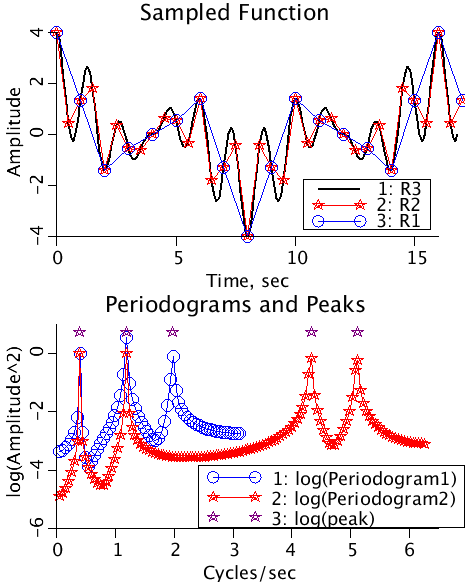A continuous function, a sum of 4 cosines, is sampled at delta-t =1/2 and undersampled at delta-t=1 illustrating the folding of frequencies around the Nyquist frequency.
Description
The Fourier transform of an undersampled continuous function "folds"
higher frequencies into lower frequencies.
Let series be of length N, and the series samples (V(i), i=1..N), sampled at
(t(i), i=1..N). The intervals between consecutive samples is t.delta. The model is
initialized with an odd number of samples. t.min=t(1). t.delta is the
interval between samples. t.ct, the number of samples, equals N.
The maximum number of frequencies is
kmax = N/2, N even,
= (N-1)/2, N odd.
The frequencies are f(i) = i/(N*t.delta), i=1..kmax.
The highest frequency is 1/(2*t.delta) which is called the Nyquist frequency,
also called the folding frequency. In radians/sec it is 2*PI/(2*t.delta).
Let
odd=0 , N is even and
odd=1, N is odd.
The forward transform is calculated as
N
A0 = Sum(V(i)/N).
i=1
for j=1 to kmax,
IF ( j not equal to kmax+odd),
N
A(j)=2/N*sum(V(i)*cos(2*PI*f(j)*(t(i)-t.min-t.delta))
i=1
N
B(j)=2/N*sum(V(i)*sin(2*PI*f(j)*(t(i)-t.min-t.delta))
i=1
ELSE
N
A(j)=sum( (-1)^(round((t(i)-t.min)/t.delta)-1)*V(i)/N).
i-1
B(j)=0.
END
END
The Periodogram estimate P(j) = A(j)*A(j)+B(j)*B(j).
The back transform is given as
for i = 1 to N
kmax
V(i)=A0+sum ( A(j)*cos(2*PI*f(j)*(t(i)-t.min-t.delta)) + B(j)*sin(2*PI*f(j)*(t(i)-t.min-t.delta)) )
j=1
The original series was built using four frequencies,
[ PI/8, 3PI/8, 11PI/8 and 13PI/8 radians] and unit amplitudes.
The periodograms (lower plot) are plotted in blue for R1 (under sampled)
and R2 (adequately sampled).
R2 with a deltaT=1/2 has a cut off frequency of 2*PI radians, and hence
the periodogram for R2 captures this information.
R1 with a deltaT=1 has a cut of frequency of PI radians. Therefore
the last frequency of 13PI/8 is folded to PI-(13PI/8-PI) = 3PI/8 and the
peak for the periodogram is boosted from 1 to 4 (1+1)^2=4. The peak
that was at 11PI/8 appears as a new peak at PI-(11PI/8)-PI) = 5PI/8.
Notice how the peaks are folded around the Nyquist frequency. The
decaying envelope around each frequency peak is because the frequencies
calculated do not match the frequencies used in the function. By shifting
the starting times of the samples (Parameter set Sharp) we can make the
peaks appear at the exact frequencies.

Upper Panel: A time series of Gaussianly distributed random numbers with mean=0, variance=4.
Lower Panel: The autocovariance function (black) and the autocorrelation function (red) are plotted as functions of the lag.
Equations
See Description above.
The equations for this model may be viewed by running the JSim model applet and clicking on the Source tab at the bottom left of JSim's Run Time graphical user interface. The equations are written in JSim's Mathematical Modeling Language (MML). See the Introduction to MML and the MML Reference Manual. Additional documentation for MML can be found by using the search option at the Physiome home page.
- Download JSim model MML code (text):
- Download translated SBML version of model (if available):
- No SBML translation currently available.
- Information on SBML conversion in JSim
We welcome comments and feedback for this model. Please use the button below to send comments:
None.
Please cite https://www.imagwiki.nibib.nih.gov/physiome in any publication for which this software is used and send one reprint to the address given below:
The National Simulation Resource, Director J. B. Bassingthwaighte, Department of Bioengineering, University of Washington, Seattle WA 98195-5061.
Model development and archiving support at https://www.imagwiki.nibib.nih.gov/physiome provided by the following grants: NIH U01HL122199 Analyzing the Cardiac Power Grid, 09/15/2015 - 05/31/2020, NIH/NIBIB BE08407 Software Integration, JSim and SBW 6/1/09-5/31/13; NIH/NHLBI T15 HL88516-01 Modeling for Heart, Lung and Blood: From Cell to Organ, 4/1/07-3/31/11; NSF BES-0506477 Adaptive Multi-Scale Model Simulation, 8/15/05-7/31/08; NIH/NHLBI R01 HL073598 Core 3: 3D Imaging and Computer Modeling of the Respiratory Tract, 9/1/04-8/31/09; as well as prior support from NIH/NCRR P41 RR01243 Simulation Resource in Circulatory Mass Transport and Exchange, 12/1/1980-11/30/01 and NIH/NIBIB R01 EB001973 JSim: A Simulation Analysis Platform, 3/1/02-2/28/07.

